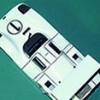noun
Definitions:
road surfacing material: a material used for surfacing roads
transitive verb (past tar·macked, past participle tar·macked, present participle tar·mack·ing, 3rd person present singular tar·macks)
Definitions:
1. cover with tarmac: to cover the surface of a road with tarmac
2. park: to park an airplane on a surfaced area at an airport or air base
[Early 20th century. Originally a trademark]
Just interested in where the term came from....Encarta says originally a trademark.
So is the name a combination of Tar and Macadam???
why do they still refer to airport with acres of concrete as tarmacs???
when was the first use of a bitumen or tar track surface (for racing)???
EDIT: Here's a shot that shows TARMAC as a brand name!! (thanks Rob)



















